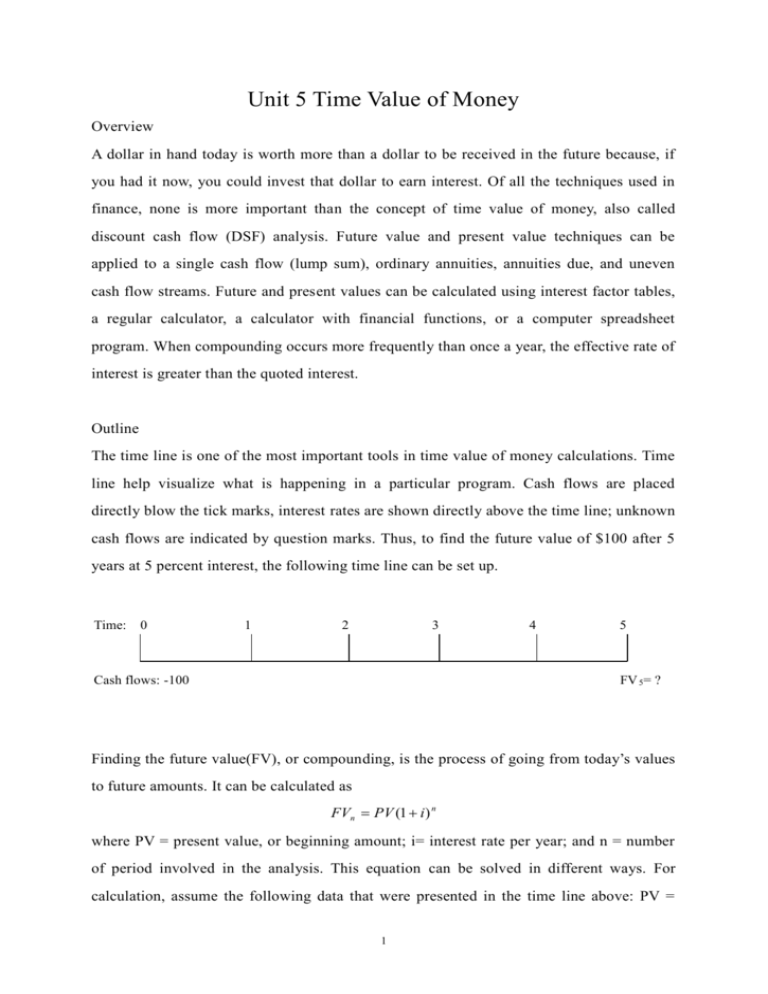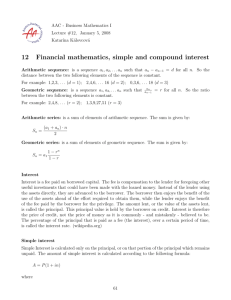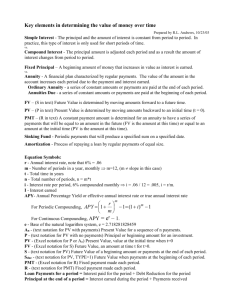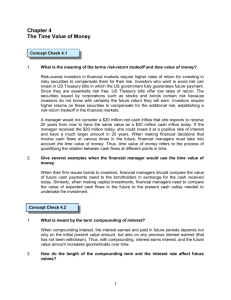5.Time Value of Money
advertisement

Unit 5 Time Value of Money Overview A dollar in hand today is worth more than a dollar to be received in the future because, if you had it now, you could invest that dollar to earn interest. Of all the techniques used in finance, none is more important than the concept of time value of money, also called discount cash flow (DSF) analysis. Future value and present value techniques can be applied to a single cash flow (lump sum), ordinary annuities, annuities due, and uneven cash flow streams. Future and present values can be calculated using interest factor tables, a regular calculator, a calculator with financial functions, or a computer spreadsheet program. When compounding occurs more frequently than once a year, the effective rate of interest is greater than the quoted interest. Outline The time line is one of the most important tools in time value of money calculations. Time line help visualize what is happening in a particular program. Cash flows are placed directly blow the tick marks, interest rates are shown directly above the time line; unknown cash flows are indicated by question marks. Thus, to find the future value of $100 after 5 years at 5 percent interest, the following time line can be set up. Time: 0 1 2 3 Cash flows: -100 4 5 FV 5= ? Finding the future value(FV), or compounding, is the process of going from today’s values to future amounts. It can be calculated as FVn PV (1 i ) n where PV = present value, or beginning amount; i= interest rate per year; and n = number of period involved in the analysis. This equation can be solved in different ways. For calculation, assume the following data that were presented in the time line above: PV = 1 $100, i= 5%, n=5. FV5 100(1 0.05) 5 127.63 . Finding present values is called discounting, and it is simply the reverse of compoundin g. In general, the present value of a cash flow due n years in the future is the amount which, if it were on hand today, would grow to equal the future amount. By solving for PV in the future value equation, the present value, or discounting, equation can be developed and written in several forms: PV 1 FVn FVn FVn ( PVIFi ,n ) n n (1 i) (1 i) There are four variables in the time value of money compounding and discounting equations: PV, FV, i, and n. If three of the four variables are known, you can find the value of the fourth. An annuity is a series of equal payments made at fixed intervals for special number of periods. If the payments occur at the end of each period, as they typically do, the annuity is an ordinary (or deferred) annuity. If the payments occur at the beginning of each period, it is called an annuity due. The future value of an annuity, FVA n, is the total amount one would have at the end of the annuity period if each payment were invested at a given interest rate and held to the end of the annuity period. □.defining FVAn is the future compound sum of an ordinary of n years, and PMT as the periodic payment, we can write n FVAn PMT (1 i ) n t PMT ( FVIFAi ,n ). t 1 □. FVIFAi,n is the future value interest factor for an annuity. □. For example, the future value of a 3-year, 5 percent ordinary annuity of $100 per year would be $100(3.1525) = $315.25. □. For an annuity due, each payment is compounded for one additional period, so the future value of the entire annuity is equal to the future value of an ordinary annuity compounded for one additional period. □. For example, the future value of a 3-year, 5 percent annuity due of $100 per year is 2 $100(3.1525)(1.05) = $331.01. the present value of an annuity is the single (lump sum) payment today that would be equivalent to the annuity payments spread over the annuity period. It is the amount today that would permit withdrawals of an equal amount (PMT) at the end (or beginning for an annuity due) of each period for n periods. □. Defining PVAn as the present value of an ordinary annuity of n years and PMT as the periodic payment, we can write n i PVAn PMT PMT ( PVIFAi ,n ). t 1 1 i n □. PVIFAi,n is the present value interest factor for an annuity. □. For example, an annuity of $100 dollar per year for three years at 5 percent would have a present value of $100(2.7232) = 272.32. □. The present value for an annuity due is PVAn ( AnnuityDue) PMT (1 i). □. For example, the present value of a 3-year, 5 percent annuity due of $100 is $100(2.7232)(1.05) = $285.94. An annuity that goes indefinitely is called a perpetuity. The payments of a perpetuity constitute an indefinite series. The present value of a perpetuity is: PV ( Perpetuity) Payment PMT . InterestRa te i For example, if the interest rate were 12 percent, a perpetuity of $1,000 a year would have a present value of $1,000/0.12 = $8,333.33. The value of a perpetuity changes dramatically when interest rates change. Many financial decisions require the analysis of uneven, or non-constant, cash flows rather than a stream of fixed payments such as an annuity. The present value of an uneven stream of income is the sum of the PVs of the individual cash flow components. Similarly, the future value of an uneven stream of income is the sum of the FVs of the individual cash flow components. Semiannual, quarterly, and other compounding periods more frequent than an annual basis 3 are often used in financial transactions. Compounding on a non-annual basis requires an adjustment to both the compounding and discounting procedures discussed previously. The effective annual rate (EAR or EFF%) is the rate that would have produced the final compounded value under annual compounding. The effective annual percentage rate is given by the following formula: m i Effective annual rate (EAR) = EFF% = 1 Nom 1.0 m Where iNom is the nominal, or quoted, interest rate and m is the number of compounding periods per year. The EAR is useful in comparing securities with different compounding periods. For example, to find the effective annual rate if the nominal rate is 6 percent and semiannual compounding is used, we have: 2 0.06 EAR 1 1.0 6.09%. 2 For annual compounding use the formula to find the future value of a single payment (lump sum): FVn PV (1 i ) n . □. When compounding occurs more frequently than once a year, use this formula: mn i FVn PV 1 Nom . m Here m is the number of times per year compounding occurs, and n is the number of years. The amount to which $1,000 will grow after 5 years if quarterly compounding is applied to a nominal 8 percent interest rate is found as follows: 0.08 FVn 1,0001 4 ( 4 )( 5 ) 1,000(1.02) 20 1,485.95. The present value of a 5-year future investment equal to $1,485.95, with an 8 percent nominal interest rate, compounded quarterly, is found as follows: 4 PV 1.485.95 0.08 1 4 ( 4 )( 5 ) 1,000. Fractional time periods are used when payments occur within periods, instead of at eith er the beginning or the end of periods. Solving these problems requires using the fraction of the time period for n, number of periods, and then solving numerically, with a financial calculator, or with a computer spreadsheet program. An important application of compound interest involves amortized loans, which are paid off in equal installments over time. The amount of each payment, PMT, is found as follows: PV of the annuity = PMT (PVIFAi,n), so PMT = PV of the annuity/PVIFA i,n. Each payment consists partly of interest and partly of the payment of principal. This breakdown is often developed in a loan amortization schedule. □. The interest component is largest in the first period, and it declines over the life of the loan. □. The repayment of principal is smallest in the first period, and it increases thereafter. Questions 1. The factor (1+i)n is known as the ________ ________ ______ _________ . 2. the process of finding present values is often referred to as _________ and is the reverse of the ________ process. 3. The PVIFi,n for 5-year, 5 percent investment is 0.7835. This is the _______ of the FVIFi,n for 5-year, 5 percent. 4. For a given number of time periods, the PVIF i,n will decline as the _______ _______ increases. 5. a series of payments of a constant amount for a specific number of periods is a(n) __________. If the payment occur at the end of each period it is a(n) _________ annuity, while if the payment occur at the beginning of each period it is an annuity _______. 6. Since different types of an investments use different compounding periods, it is 5 important to distinguish between the quoted, or________, rate and the effective annual interest rate. 7. __________ loans are those that are paid off in equal installments over time. 8. If a bank uses quarterly compounding for saving accounts, the nominal rate will be greater than the effective annual rate (EAR). a. True b. False 9. Which of the following would cause a project to look have a lower present value? a. The discount rate decreases b. The cash flows are extended over a longer period of time. c. The discount rate increases. d. Statements b and c are correct. e. Statements a and b are correct. 10. As the discount rate increases without limit, the present value of a future cash inflow a. Gets large without limit. b. Stays unchanged. c. Approaches zero. d. Gets smaller without limit; that is, approaches minus infinity. e. Goes to ein. Problems 1. Assume that you purchase a 6-year, 8 percent savings certificate for $1,000. If interest is compounded annually, what will be the value of the certificate when it matures? a. $630.17 2. b. $1,469.33 c. $1.677.10 d. $1,586.87 e. $1,766.33 A friend promises to pay you $600 two years from now if you loan him $500 today. What annual interest rate is your friend offering? a. 7.5% b. 8.5% c. 9.5% d. 10.5% e. 12.5% 3. you are offered an investment opportunity with the “guarantee” that your investment will double in 5 years. Assuming annual rate of return would this investment provided? a. 40.00% b. 100.00% c. 14.87% d. 20.00% e. 18.74% 4. you decide to begin saving towards the purchase of a new car in 5 years. If you put 6 $1,000 at the end of each of the next 5 years in savings account paying 6 percent compounded annually, how much will you accumulate after 5 years? a. $6,691.13 b. $5,637.09 c. $1,338.23 d. $5,975.32 e. $5,731.94 5. Refer to problem 4. What would be the ending amount if the payments were made at the beginning of each year? a. $6,691.13 b. $5,637.09 c. $1,338.23 d. $5,975.32 e. $5,731.94 6. Refer to problem 4. What would bre the ending amount if $500 payments were made at the end of each 6-month period for 5 yers and the account paid 6 percent compounded semiannually? a. $6,691.13 7. b. $5,637.09 c. $1,338.23 d. $5,975.32 e. $5,731.94 How much would you be willing to pay today for an investment that would return $800 each year at the end of each of the next 6 years? Assume a discount rate of 5 percent. a. $5,441.13 8. b. $4,800.00 c. $3,369.89 d. $4,060.55 e. $4,632.37 If you would like to accumulate $7,500 over the next 5 years, how much must you deposit each six months, starting six months from now, given a 6 percent interest rate and semiannual compounding? a. $1,330.47 b. $879.23 c. $654.23 d. $569.00 e. $732.67 9. What is the present value (t=1) of the following cash flows if the discount rate is 12 percent? 0 1 0 2,000 a. $4,782.43 2 3 2,000 4 2,000 b. $4,440.51 3,000 c. $4,221.79 5 -4,000 d. $4,041.23 e. $3,997.98 10. What is the effective percentage rate (EAR) of 12 percent compounded monthly? a. 12.00% b. 12.55% c. 12.68% d. 12.75% e. 13.00% 11. Answers for questions (Time Value of Money) 1. future value interest factor 2. discounting; compounding 7 3. reciprocal 4. interest rate 5. annuity; ordinary; due 6. nominal; effective 7. Amortized 8. b. The EAR is always greater than or equal to the nominal rate. 9. d. the slower the cash flows in and the higher the interest rate, the lower the present value. 10. c. As the discount rate increases, the present value of a future sum decreases and eventually approaches zero. Answers for problems (Time Value of Money) 1. d. FVn = $1,000(FVIF8%, 6) = $1,000(1.5869) = $1,586.90 2. c. 600 = 500 (1+i)2 3. c. 1 i 2 5 1+ i 1.20 1.095 1 i 5 2 1.1 4 8 7i= 14.87% 5 4. b. FVA5 1,000 1 6% 5t t 1 1,000(1.06) 4 1,000(1.06) 3 1,000(1.06) 2 1,000(1.06) 1,000 5637.09 5. d. FVAn ( AnnuityDue) $1,000(5,6371)(1.06) 5,975.33 . 10 6. e. FVA10 500 (1 0.03)10t 500(11.464) 5,732.00 t 1 t 1 7. d. PVA6 800 800(5.0757) 4,060.56 . t 1 1 0.05 6 10 8. c. 7,500 PMT (1 0.03)10t PMT (11.464) . PMY = $654.22. t 1 The formula to get the sum of the flat ratio series: a1 +a1q +a1q2 +a1q3 + … a1qn-1 = 10 (1.03) t 1 10t a1 (1 q n ) . 1 q 1.00(1 1.0310 ) 1 1.03 1.03 1.03 1.03 11.4638 1 1.03 2 3 9 9. b. PV = 2,000(PVIVA12%, 3) +3,000(PVIF12%,5) – 4,000(PVIF12%, 5) = 2,000(2.4018) + 3,000(0.6355) + 4,000 (0.5674) = 4,440.50 8 12 10. c. EAR (1 i Nom m 0.12 ) 1 1 1.0 0.1268 12.68% m 12 9








